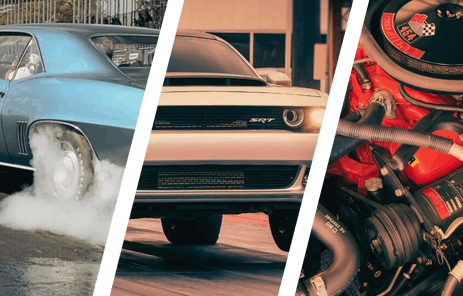
Proform Parts sells products that support both EFI and carbureted fuel systems, so the question of “which is better” comes up often from consumers. Many enthusiasts often mistake fuel injection systems as a more modern system than a carburetor. Actually, fuel injection goes back as far as the first combustion engines in the 1880s. It was even more expensive to use, and more complicated to users in those days than it is now.
Fuel injection started to gain wider acceptance in the 1920s with diesel engines that use a compression ignition system. It wasn’t until the 1950s when mechanical fuel injection, and to a lesser extent, electronic fuel injection was being used in gas engines from the factory. Modern fuel injection has taken over as the only fuel system on factory cars and trucks due to emission standards. Motorsports and hardcore enthusiasts still favor the carburetor for all-out performance.
To determine which is best for your application, it’s important to understand the basics of how each component works.

Carburetor
The bare basics of an internal combustion engine is that gas must get into the combustion chamber for the engine to work. Carburetors do this by allowing an amount of fuel to flow through jets and into the flow of air that enters the carburetor. The amount of fuel depends completely on the amount of air that can be pulled into the carburetor’s venturi. The single issue with obtaining efficiency using a carburetor is the system can’t monitor the air-to-fuel ratio for each individual cylinder.
If each cylinder had a carburetor, this would be much less of an issue. As it stands with a conventional carburetor setup, the optimal air-to-fuel ratio to each cylinder is approximated for best efficiency. That being said, carburetors do last longer than most fuel injection systems, are easier to install and maintain, have fewer electronics and fuel lines, and are less expensive on the whole.
Fuel Injection
Efficiency is the main benefit of using a fuel injection system. The amount of fuel and air can be released into the combustion chamber according to engine load conditions and environmental factors like altitude and air temperature. The sensors and electronics in the system will calculate and constantly adjust to the fuel requirement.
These systems are sophisticated and require complicated electrical components that cost a lot more than a carbureted system. If there is a problem and you need to pull over to the side of the road, you probably won’t be able to fix it on the spot where you stand a good chance of repairing a carburetor under the same circumstances.

Which is Best?
According to Proform Parts, the carburetor typically produces more power vs. many EFI applications. Proform declares this is because carburetors shear the fuel into droplets of mist spray, allowing the fuel to stay suspended in the air and mix inside the manifold. This atomization cuts down the chance of the fuel dropping out of suspension, for more efficient combustion.
EFI, in comparison, dispenses fuel under pressure, and the fuel is less easily atomized into the air. Reversion pulses inside a typical EFI intake plenum can allow the fuel to separate, which will reduce combustion efficiency. According to these experts, carburetors fair very well when compared to EFI systems. The key they say is optimal carburetor efficiency.
Determining Carburetor Size
The key to optimal carburetor efficiency for a given engine configuration comes down to airflow capability and atomization of fuel into the combustion chamber. A carburetor that is too big will be lean at wide-open throttle (WOT) and be overly rich at idle. This means the fuel isn’t being pulled through the boosters because there is not enough vacuum at WOT and the fuel is not breaking at idle.

Here is how Proform Parts breaks it all down:
Bigger isn’t always better when it comes to determining CFM for your carburetor. Components such as camshafts, converters, heads, and intake should be mapped out already (per manufacturer’s specs) and can have an impact on the type of carburetor you choose.
You also have to be realistic about the engine and what your use is. Rather than determine your carb by CFM rating, instead look at the type of boosters, venturi sizes, and butterfly sizes when determining the carburetor for your application.
Engine CID x Max RPM/3456 is the formula to help them select a carburetor. Let’s take a small block 350 Chevy for our example at 6,000 rpm (redline).
350 x (6000/3456) =
350 x 1.736 =
= 607.63
A 600 cfm carburetor would more than suffice. Keep in mind, the formula figures 100-percent volumetric efficiency, which most engines do not achieve. Use the chart provided, or various online “Carb Calculators” available, to help you decide.
Carburetor tuning is done the old-fashioned way – with a few wrenches, a screwdriver, and a few specialized tools. The old school guys used spark plugs to monitor their engine tuning. Reading spark plug markings will tell you what is happening inside the combustion chamber and if it’s lean or rich.
Although EFI can monitor some of these things for you, there’s no substitute for having the knowledge yourself, and once you get the hang of it, you can trust your own judgment rather than hoping a computer was programmed correctly.
For more information on the products that Proform Parts sell, visit them online at www.proformparts.com.
You might also like
PRI 2025: Drop Valvetrain Weight Using PBM Titanium Valves
PBM enters the valve market with their titanium valves that reduce reciprocating weight, ensuring precise valve control.


